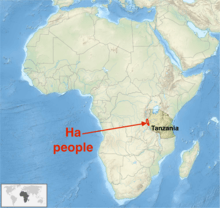Ha people

The Ha, also called Waha (singular Muha) or Abaha, are an ethnic and linguistic group found in Kigoma Region in northwestern Tanzania bordering the Lake Tanganyika.[1][2] In 2001, the Ha population was estimated to number between 1 to 1.5 million, making them one of the large ethnic groups in ethnically diverse Tanzania.[1][3][4]
Their language is a Bantu language,[5] and is called the Ha language, also called Kiha, Ikiha or Giha. It is closely related to the Kirundi and Kinyarwanda spoken in neighbouring Burundi and Rwanda, and belongs to the Niger-Congo family of languages.[4]
Society and culture
The Ha people call the lake bordering area they live in as Buha, and the region consists of grasslands and open woodlands.[1] They are culturally an Afro-Asiatic agricultural group who share the northwestern part of Tanzania with the Sukuma, the Haya, the Zinza, the Hangaza and the Subi ethnic groups.[6]
The Ha people grow sorghum, millet, corn (maize), cassava, yams, peanuts and other crops.[1] Wherever the tse tse fly problem is minor, the Ha people raise cattle, goats and other livestocks that are highly valued in the Ha society and gifted at marriage. In the northern parts of their territories, where the tse tse fly problem is significant, they hunt and gather honey.[7]
The Ha people live in dispersed homes, typically as a joint family whose male members are related by their lineage. Since about the 18th century, the Tutsi people have lived among the Ha people, but as a small minority (2%), but typically in an aristocratic role. The two ethnic groups substantially share language, culture and some have intermarried.[1] The Ha women share some of the cultural traditions with other neighboring ethnic groups, such as wearing the Kitindi, or coiled bracelets made of copper wire worn near the elbow.[8]
The Ha people are animists who revere their ancestors as well as nature spirits. Their traditional religion includes Imana deity as their supreme being and creator.[1] They have witnessed Islamic missionary activity from the Arabs since the pre-colonial era and Christian missionary activity during the German and British colonial era thereafter from Roman Catholics, Anglicans, Lutherans, and others.[1][9]
In later years, many men from the Ha people have wandered to the Tanzanian coastline to work at sisal plantations there.[7]
See also
References
- 1 2 3 4 5 6 7 Ha people, Tanzania
- ↑ David Lawrence (2009). Tanzania and Its People. New Africa Press. pp. 25, 102–104. ISBN 978-1-4414-8692-9.
- ↑ James Stuart Olson (1996). The Peoples of Africa: An Ethnohistorical Dictionary. Greenwood. p. 215. ISBN 978-0-313-27918-8.
- 1 2 Languages of Tanzania
- ↑ Anthony Appiah; Henry Louis Gates (2010). Encyclopedia of Africa. Oxford University Press. p. 546. ISBN 978-0-19-533770-9.
- ↑ James Clagett Taylor (1963). The Political Development of Tanganyika. Stanford University Press. pp. 31–32. ISBN 978-0-8047-0147-1.
- 1 2 "Ha - folkegruppe". Store norske leksikon (in Norwegian). Retrieved 18 August 2010.
- ↑ John E. Flint (1977). The Cambridge History of Africa. Cambridge University Press. p. 302. ISBN 978-0-521-20701-0.
- ↑ Frieder Ludwig (1999). Church and State in Tanzania: Aspects of Changing in Relationships, 1961-1994. BRILL Academic. pp. 175–176. ISBN 90-04-11506-4.
External links
- Ethnologue entry for Ha
- Official government report on Kigoma region containing information on the Ha